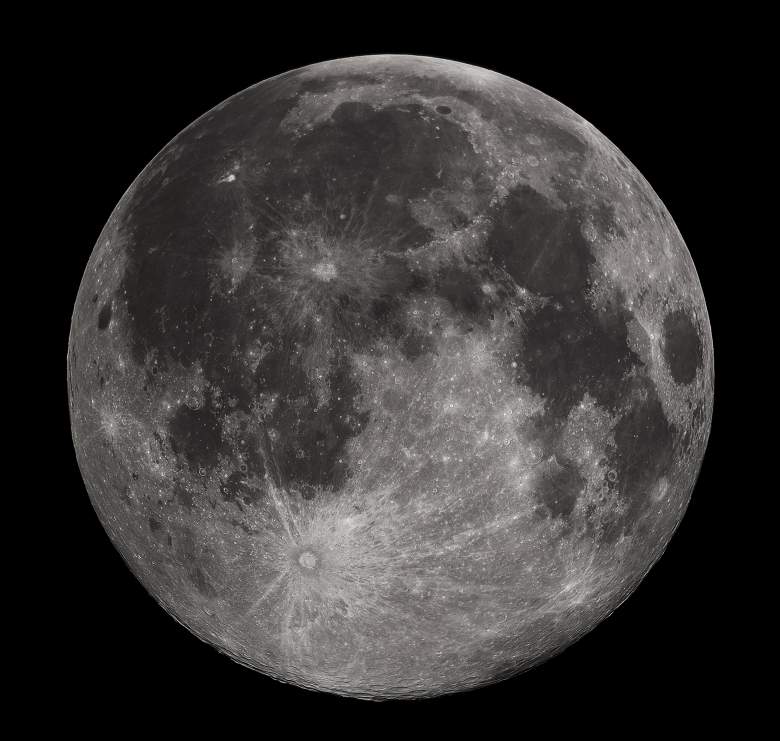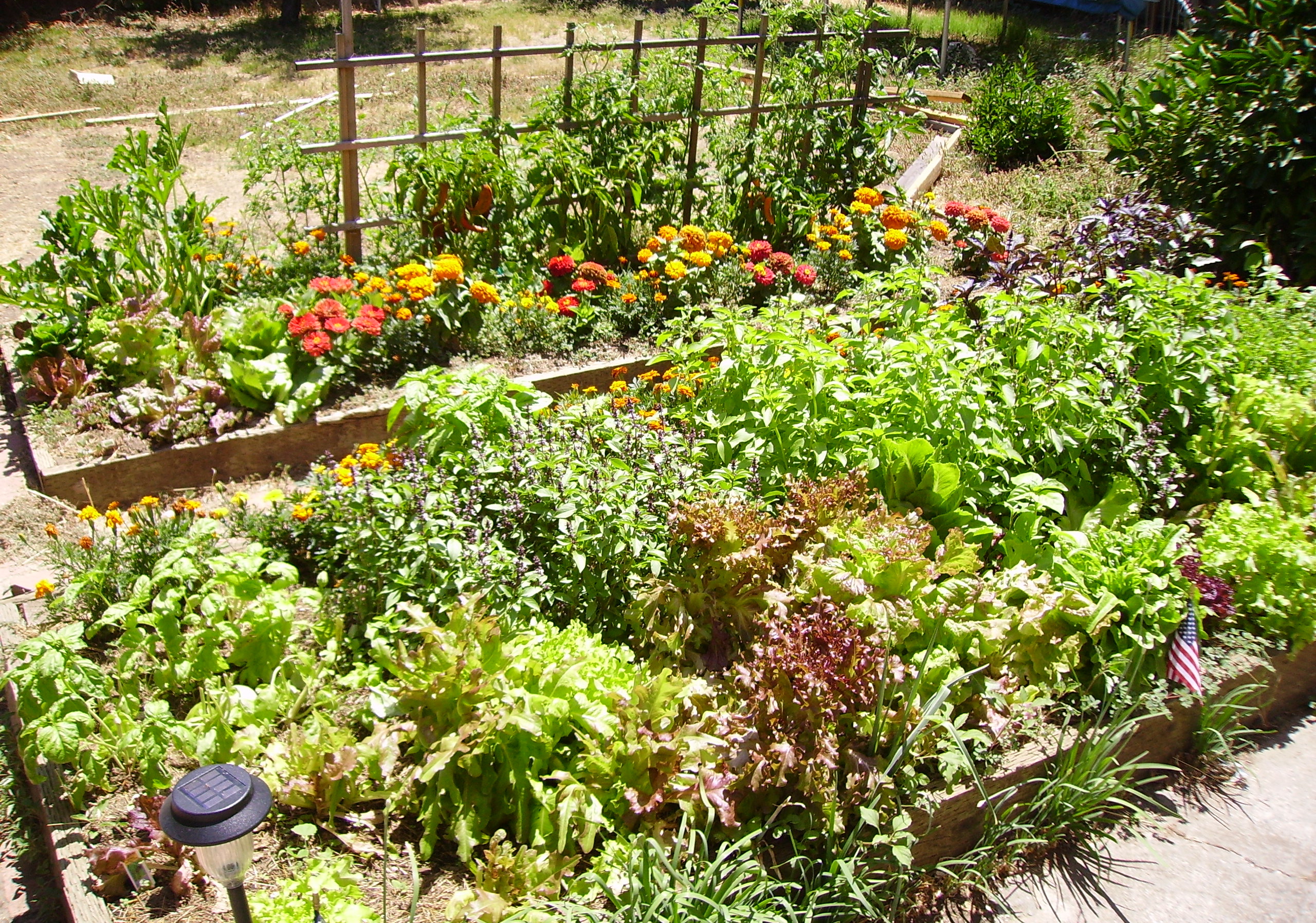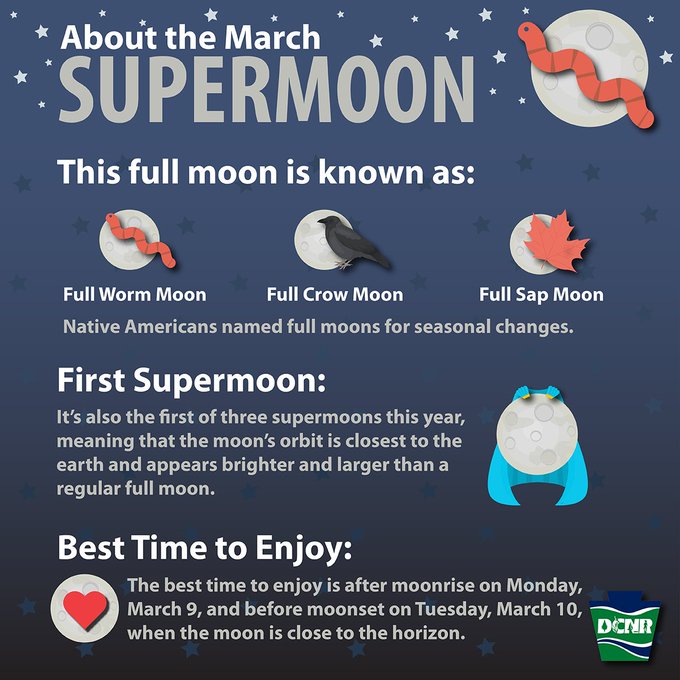
Wikipedia
A full moon known as the worm moon will take place on March 9. It will reach full peak at 1:48 p.m. Eastern Standard Time. It’s the first of three supermoons that will occur in 2020. This full moon is called a worm moon because it happens at the time of year when the ground softens enough to allow earthworms to appear in the ground, signalling the start of spring.
Here’s what you need to know.
1. The Full Worm Moon Will Be At Its Peak on Monday March 9 At 1:48 P.M. EST in the United States
The worm moon will be at its peak visibility at 1:48 p.m. Eastern Standard Time on Monday, March 9, according to the Old Farmer’s Almanac. But the worm moon will still be “spectacularly bright” as it rises above the horizon during sunset.
The center of the worm moon will be 222,081 miles from Earth, according to EarthSky.
“In North and South America, the moon will turn full during the daylight hours on March 9, when the moon is still beneath the horizon. Even so, the moon remains more or less opposite the sun in our sky for a few days. So watch for a bright full-looking moon to light up the night sky from dusk till dawn on the nights of March 8 and 9,” EarthSky reports.
A supermoon “occurs when the moon’s orbit is closest (perigee) to Earth at the same time it is full,” according to NASA.
“The term ‘supermoon’ was coined in 1979 and is often used today to describe what astronomers would call a perigean (pear-ih-jee-un) full moon: a full moon occurring near or at the time,” NASA said. “High tides and low tides will be more extreme with a perigean full moon and more so for an extreme perigean full moon.”
2. The Full Moon Is Called a Worm Moon Because It Happens When the Ground Is Soft Enough To Allow Earthworms To Appear, Marking the Beginning of Spring
The March 9 supermoon is called a worm moon because it occurs just before springtime when the ground becomes soft enough for earthworms to appear.
According to the Old Farmer’s Almanac:
“At this time of the year, the ground begins to soften enough for earthworm casts to reappear, inviting robins and other birds to feed—a true sign of spring. Roots start to push their way up through the soil, and the Earth experiences a re-birth as it awakens from its winter slumber.”
While worm moon is the most common name for this supermoon, it’s also sometimes called the Lenten Moon, Crow Moon, Crust Moon, Chaste Moon, Sugar Moon, and Sap Moon.
3. The Worm Moon Is One of Three Supermoons to Occur in 2020
What is a supermoon? The term supermoon is “the popular nickname given to a full Moon that coincides with perigee, which is the point in the Moon’s orbit of Earth where it’s closest to our planet,” The Old Farmer’s Almanac explains. “While at perigee, the full Moon appears a bit brighter and about 7% larger than a typical full Moon. However, don’t go out on the night of March 9 expecting to see a Moon that’s noticeably more massive. Unless you were to see them side by side, the differences between a supermoon and a regular full Moon can be very difficult to perceive!”
Simply put, a supermoon is a full moon that appears larger than a typical full moon because it is closer to Earth. According to the Old Farmer’s Almanac, which was founded in 1792, there will be three supermoons in 2020:
Worm Moon: March 9 at 1:48 P.M EDT
Pink Moon: April 7 at 10:35 P.M. EDT
Flower Moon: May 7 at 6:45 A.M. EDT
April’s full Moon is the closest supermoon of the year, with the moon at a distance of approximately 221,800 miles from Earth.
4. The March 9 Worm Moon Is a Good Time To Start Gardening, Experts Say

Gardening by the moon has become a trend in gardening. The Old Farmer’s Almanac says “the basic idea behind Gardening by the Moon is that the cycles of the Moon affect plant growth. Just as the Moon’s gravitational pull causes tides to rise and fall, it also affects moisture in the soil.”
“Therefore, it’s said that seeds will absorb more water during the full Moon and the new Moon, when more moisture is pulled to the soil surface. This causes seeds to swell, resulting in greater germination and better-established plants,” it says.
There are two times between a new moon and a full Moon, which is referred to as the waxing of the moon, and the time between a full moon and a new moon, which is called the waning of the Moon. The best time to garden certain types of plants during the waning of the Moon and other types during the waxing.
5. American Poet Mary Oliver Wrote About the Worm Moon In Her 1979 Collection Called ‘Twelve Moons’
Mary Oliver is an American poet who died at the age of 83 in January 2019 whose work explores “the link between nature and the spiritual world,” NPR reported in her obituary.
In 1979, Oliver published a collection of poems called “Twelve Moons” that features a poem about the worm moon. Here’s an excerpt from the blog, A Poem A Day:
The season of curiosity is everlasting
and the hour for adventure never ends,
but tonight
even the men who walked upon the moon
are lying content
by open windows
where the winds are sweeping over the fields,
over water,
over the naked earth,
into villages, and lonely country houses, and the vast cities
because it is spring;
because once more the moon and the earth are eloping –
a love match that will bring forth fantastic children
who will learn to stand, walk, and finally run
over the surface of earth;
who will believe, for years,
that everything is possible.
